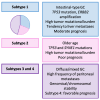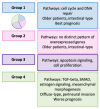Molecular Classifications in Gastric Cancer: A Call for Interdisciplinary Collaboration
- PMID: 38473896
- PMCID: PMC10931799
- DOI: 10.3390/ijms25052649
Molecular Classifications in Gastric Cancer: A Call for Interdisciplinary Collaboration
Abstract
Gastric cancer (GC) is a heterogeneous disease, often diagnosed at advanced stages, with a 5-year survival rate of approximately 20%. Despite notable technological advancements in cancer research over the past decades, their impact on GC management and outcomes has been limited. Numerous molecular alterations have been identified in GC, leading to various molecular classifications, such as those developed by The Cancer Genome Atlas (TCGA) and the Asian Cancer Research Group (ACRG). Other authors have proposed alternative perspectives, including immune, proteomic, or epigenetic-based classifications. However, molecular stratification has not yet transitioned into clinical practice for GC, and little attention has been paid to alternative molecular classifications. In this review, we explore diverse molecular classifications in GC from a practical point of view, emphasizing their relationships with clinicopathological factors, prognosis, and therapeutic approaches. We have focused on classifications beyond those of TCGA and the ACRG, which have been less extensively reviewed previously. Additionally, we discuss the challenges that must be overcome to ensure their impact on patient treatment and prognosis. This review aims to serve as a practical framework to understand the molecular landscape of GC, facilitate the development of consensus molecular categories, and guide the design of innovative molecular studies in the field.
Keywords: TP53; classification; gastric cancer; immune; mesenchymal; microsatellite instability; molecular; prognosis; tumor mutational burden.
Conflict of interest statement
The authors declare no conflicts of interest.
Figures












Similar articles
-
Clinical characteristics and prognostic significance of TCGA and ACRG classification in gastric cancer among the Chinese population.Mol Med Rep. 2020 Aug;22(2):828-840. doi: 10.3892/mmr.2020.11183. Epub 2020 May 22. Mol Med Rep. 2020. PMID: 32468041 Free PMC article.
-
Reproduction of the Cancer Genome Atlas (TCGA) and Asian Cancer Research Group (ACRG) Gastric Cancer Molecular Classifications and Their Association with Clinicopathological Characteristics and Overall Survival in Moroccan Patients.Dis Markers. 2021 Jul 28;2021:9980410. doi: 10.1155/2021/9980410. eCollection 2021. Dis Markers. 2021. PMID: 34367379 Free PMC article.
-
Comparison and applicability of molecular classifications for gastric cancer.Cancer Treat Rev. 2019 Jul;77:29-34. doi: 10.1016/j.ctrv.2019.05.005. Epub 2019 May 28. Cancer Treat Rev. 2019. PMID: 31195213 Review.
-
[Research progress in molecular classification of gastric cancer].Zhonghua Wei Chang Wai Ke Za Zhi. 2016 Sep 25;19(9):1072-1076. Zhonghua Wei Chang Wai Ke Za Zhi. 2016. PMID: 27680079 Chinese.
-
What's New in Gastric Cancer: The Therapeutic Implications of Molecular Classifications and Future Perspectives.Int J Mol Sci. 2018 Sep 7;19(9):2659. doi: 10.3390/ijms19092659. Int J Mol Sci. 2018. PMID: 30205505 Free PMC article. Review.
Cited by
-
Overexpression of miR-195-5p Suppresses Gastric Cancer Progression by Regulating LAMP2-Mediated Autophagy.Biochem Genet. 2025 May 5. doi: 10.1007/s10528-025-11120-4. Online ahead of print. Biochem Genet. 2025. PMID: 40325317
-
Identification of Immune Infiltrating Cell-Related Biomarkers in Early Gastric Cancer Progression.Technol Cancer Res Treat. 2024 Jan-Dec;23:15330338241262724. doi: 10.1177/15330338241262724. Technol Cancer Res Treat. 2024. PMID: 38860335 Free PMC article.
-
Bioinformatics Analysis and Validation of Potential Markers Associated with Prediction and Prognosis of Gastric Cancer.Int J Mol Sci. 2024 May 28;25(11):5880. doi: 10.3390/ijms25115880. Int J Mol Sci. 2024. PMID: 38892067 Free PMC article. Review.
-
MAZ-mediated LAMA5 transcription activation promotes gastric cancer progression through the STAT3 signaling.Funct Integr Genomics. 2025 Mar 12;25(1):59. doi: 10.1007/s10142-025-01574-5. Funct Integr Genomics. 2025. PMID: 40072648 Free PMC article.
-
Beyond Biomarkers: Machine Learning-Driven Multiomics for Personalized Medicine in Gastric Cancer.J Pers Med. 2025 Apr 24;15(5):166. doi: 10.3390/jpm15050166. J Pers Med. 2025. PMID: 40423038 Free PMC article. Review.
References
Publication types
MeSH terms
LinkOut - more resources
Full Text Sources
Medical
Research Materials
Miscellaneous

